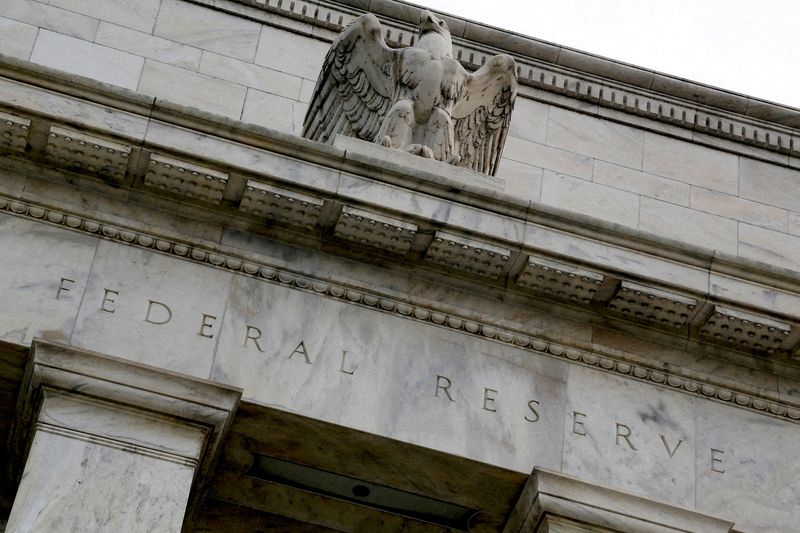
© Reuters. FILE PHOTO: An eagle tops the U.S. Federal Reserve building’s facade in Washington, July 31, 2013. REUTERS/Jonathan Ernst
By Michael S. Derby, Ann Saphir and Howard Schneider
WASHINGTON (Reuters) -Three Federal Reserve officials kept the door open on Thursday to more rate rises aimed at lowering high levels of inflation, with two noting banking sector problems could generate enough headwinds on the economy to help cool price pressures faster than expected.
“Inflation remains too high, and recent indicators reinforce my view that there is more work to do to bring inflation down to the 2% target associated with price stability,” Federal Reserve Bank of Boston leader Susan Collins said in remarks to a gathering of the National Association for Business Economics.
But Collins, who does not have a vote on the rate-setting Federal Open Market Committee this year, also said that after last week’s quarter percentage point increase, the central bank is likely close to done on rate rises.
Citing U.S. central bank forecasts released last Wednesday that pointed to one more 25-basis-point increase this year, the official said she saw that projection “as reasonably balancing the risk of monetary policy not being restrictive enough to bring inflation down, and the risk that activity slows by more than needed to address elevated price pressures.”
Speaking separately, Minneapolis Fed leader Neel Kashkari, who does have a vote on the FOMC, also said the institution has “more work to do,” but he did not characterize what action he’d like to see take place.
One key force taking some pressure off the Fed on the inflation front is the emergence of troubles in the banking system kicked off by the failure of Silicon Valley Bank and other financial institutions. As the Fed moved toward its last policy meeting, the bank failures rattled financial markets and compelled authorities to bolster market liquidity. Banks also tapped record levels of emergency liquidity from the central bank.
Banks are “strong and resilient,” Collins said, but are likely to pull back on offering credit, which in turn will weigh on overall activity. “These developments may partially offset the need for additional rate increases.”
Richmond Fed leader Thomas Barkin said in a speech that monetary policy needs to be “nimble” in current circumstances. He also said financial sector issues could help the Fed achieve its mission to get inflation back to 2% more quickly, while adding a note of caution about the uncertainty of what lies ahead.
“It is possible that tightening credit conditions, along with the lagged effect of our rate moves, will bring inflation down relatively quickly,” Barkin said, while there are still a number of reasons why it could take time for price pressure to ease. The bank president does not vote this year on the FOMC.
But Kashkari also noted that dealing with the current banking problems are in their early days. “Banking panics and banking stresses tend to take longer than you think” to resolve, he said. “It’s probably going to take us a while to understand, are there more losses out there?”
SOLID FOOTING
In her remarks, Collins was upbeat on the economy but hinted at a looming slowdown, while also saying some rise in unemployment is likely needed to help lower wage price inflation.
Recent data “show signs of more underlying strength in the economy than many anticipated,” and the vigor of hiring and spending “might reflect the fact that policy did not enter fully restrictive territory until the second half of 2022, and it may be too soon to see its full effects on real activity,” Collins said.
But she added that “there are some emerging signs of slowing labor demand” as job sectors hard hit by the coronavirus pandemic are now close to recovering. Collins also said “while we may be seeing some initial signs of wage moderation, more will be needed for a sustained improvement in price inflation.”
Source: Investing.com




























